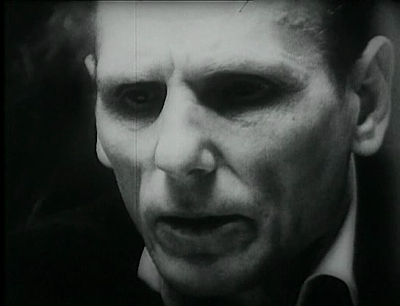 |
| Bylem Zanierzem(1970)/ Krystof Kieslowski |
In Bylem Zonierzem(1970), there is a much larger discourse than what you just see; or as Kielowski proves, what you merely see. The documentary, as Kielowski perceives it, is burdened with the need to ‘tell’: as such, the function of the documentary-image is information, or the Daney-image, i.e. the image as an instrument of information. But an image is, by the inherent limitations that plague it, of a wholly arbitrary nature – its only descriptive quality is strictly pictorial: what you can perceive visually, but even then, it is terribly restrictive as and so far as a tool of information. A face in a close-up is a face, a bolt is a bolt, a texture is a texture; not much else. You can clearly see the face, or the bolt, or the texture, but merely its pictorial representation devoid of its context (or text) does not tell you precisely what it is that you are seeing : whose face, which bolt, what texture. This limitation, I daresay, is all the more pronounced in the film-image (as opposed to the still frame), because a frame within a film, grabbed and posted on a blog by itself and with no larger framework to support it, is essentially nothing – just something that looks like something. As such, the capacity of information within an image is inconsequential. Kielowski’s emphasis on the documentary as a medium of information, however, forces him to look at other means beyond the image. Predictably, he looks towards text.
Bylem Zonierzem (1970) features a number of war veterans, all blinded by their participation in the event, verbally reciting their experiences of the war. Kielowski frames them all in a progressing series of extremely tight close-ups, filmed with long lenses so as to cause the visage to radiate in a sea of blur. It seems like a peculiar ploy at first, but reveals a much larger commentary on the tedium of imagery as it progresses. There are about five soldiers (seated, presumably, around a table), but because of the curious aesthetic, there seem a lot more – as one by one, they extol on the horror of war (a point the film is not interested in) and we ‘see’ them do it in an unending series of extreme close-ups. The adoption of this scheme means that Kielowski reduces the documentary film to the entrails, and exposes it for what it is : text overruling the image in an effort to ‘inform’. The film features, successively, around a hundred extreme close-ups, all similar in their magnification and image size, to the point that the image finally becomes redundant and ceases to be important anymore. At which point, Kielowski breaks the film down to a white screen with black text written on it – its opposite, ofcourse, is the most fundamental instance of the domination of the text over image.
It is ironic, but not really, that Kieslowski would turn to fiction later in his life because that seemed to make him a greater offer of truth – Kieslowki, like Kiarostami knew, that while the fiction-image is ‘truth’, the documentary-image is ‘information’.




No comments:
Post a Comment